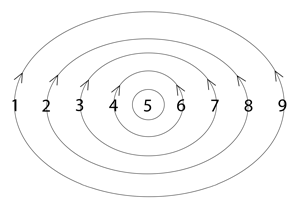surrender
4-1-5
Conventional Understanding
In conventional usage, surrender signifies giving up, relinquishing control, or submitting to a dominant force. Religious contexts often frame it as yielding one’s will to a higher power, while military contexts emphasize defeat and capitulation. This understanding positions surrender as a passive, sometimes humiliating act where one party concedes power to another. Daily life reflects this through phrases like “I surrender” meaning “I give up,” suggesting defeat rather than transformation. The underlying assumption is that surrendering represents weakness, loss, or failure – an understanding that shapes how we approach challenges, relationships, and spiritual practices.
Resonant Understanding
Mathematical analysis of language reveals “surrender” carrying a 4-1-5 resonance pattern, functioning at Position 5 in the experiential triad. This pattern demonstrates how surrender operates not as passive submission but as the experiential field itself, where conscious awareness becomes creative potential. Like water finding its natural course by yielding to gravity rather than fighting it, surrender represents alignment with natural creative flow rather than abdication of responsibility. This challenges conventional views dramatically – what religious traditions frame as “submitting to God’s will” actually reflects consciousness recognizing and aligning with the inherent organization of the experiential field itself.
Expressions Spectrum Analysis
In balanced expression, this resonance pattern appears as “surrender,” “coherent form,” “be all that you can be,” “individuated reality,” and “I am self-organizing.” These expressions reveal how surrender naturally corresponds with recognizing and aligning with one’s authentic nature rather than imposing artificial constraints. When surrender functions in balance, it manifests as “valuing” and “response to unfolding” – conscious participation in the natural organization of experience without attempting to control outcomes or disconnect from the process.
When over-modulated, expressions include “I hold the power,” “simulated reality,” “fraud,” and “overpowering.” These reveal how attempting to control the experiential field distorts the natural surrender function, creating artificial realities rather than authentic engagement. “Human will” and “overachiever” appear in this column, suggesting how the effort to maintain control corresponds with forcing reality rather than allowing natural organization. This represents the opposite of true surrender – attempting to impose will upon the experiential field rather than recognizing how experience naturally organizes.
Under-modulated expressions such as “dependency,” “decaying,” “obligation,” and “uncertain information” demonstrate what happens when insufficient conscious participation meets the experiential field. “I do not want to be responsible” particularly illustrates how under-modulation differs from balanced surrender – not conscious alignment but abdication of participatory awareness. These expressions reveal disconnection from the experiential field rather than conscious engagement with it.
Beyond these modulation patterns, expressions like “kundalini,” “joy,” “regeneration,” and “unified field” appear in the uncategorized column. “The pulse of creation” and “center of the world” suggest foundational aspects of reality related to this resonance pattern, while “universe” points to the broader context where surrender functions.
Russell’s Cosmogony Connection
Walter Russell describes a universe operating through what he calls “rhythmic balanced interchange” – a principle that illuminates the nature of surrender. In his work, Russell explains: “All motion is a continuous two-way journey in opposite directions between two destinations.” This principle directly relates to surrender’s balanced expressions like “coherent form” and “response to unfolding,” revealing how true surrender involves conscious participation in this natural rhythmic flow rather than fighting against it.
In “The Universal One,” Russell further clarifies: “The fulcrum from which all power springs is KNOWLEDGE. When man has that omniscience which is unfolding in cosmic man, he will no longer misuse, break or disobey God’s law because of being unaware of it. He will command it because he will know the law.” This illuminates how surrender functions at Position 5 – not as submission to external authority but as alignment with universal law through recognition. True surrender emerges from knowing the organizing principles inherent in reality rather than attempting to impose artificial order or disconnecting from participation.
Think of how a skilled sailor works with wind and current rather than fighting against these forces. The sailor doesn’t merely submit passively to these elements, nor attempt to overpower them, but uses knowledge to align their actions with natural patterns. Similarly, balanced surrender isn’t about yielding control to outside forces or asserting dominance, but recognizing and aligning with the rhythmic balanced interchange that already organizes experience. This explains why surrender in its balanced expression appears as “coherent form” and “I am self-organizing” – it represents conscious participation in natural organization rather than either forced control or passive submission.
Practical Implications
This understanding transforms our relationship with surrender from passive submission to conscious alignment. Rather than “giving up” control to an external authority, surrender becomes recognizing and participating in the natural organization of experience itself. This explains why religious traditions emphasizing surrender often lead to greater peace and fulfillment – not because they encourage submission to authority, but because they help practitioners align with natural creative flow rather than fighting against it.
In daily practice, this means approaching challenges by first recognizing the inherent organization already present rather than immediately attempting to impose our will or disconnecting from responsibility. When facing difficulties, instead of asking “How can I control this?” or “How can I escape this?”, we might ask “What is the natural organization trying to express here?” This shifts surrender from defeat to discernment – consciously participating in reality’s unfolding rather than fighting against or withdrawing from it.
This perspective liberates surrender from religious contexts while honoring the wisdom they contain. It explains why surrendering to “God’s will” often creates more harmony – not because an external deity demands submission, but because this practice helps align consciousness with the inherent organization of reality itself. By recognizing surrender as the experiential field rather than passive submission, we transform our relationship with both religious teachings and everyday challenges, discovering that true power emerges not from control but from conscious alignment with the organizing principles that already permeate our experience.
Walter Russell’s quotes are from his book, “A New Concept of the Universe” and Universal One.


